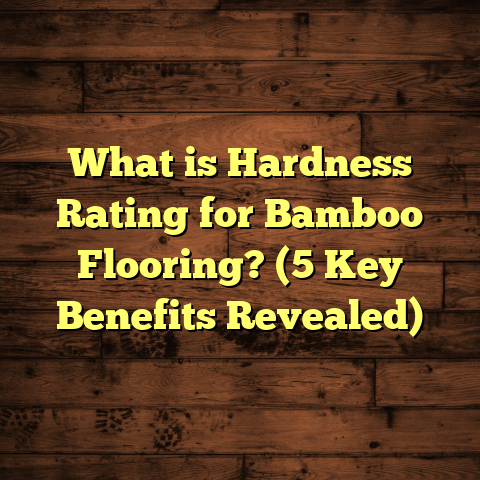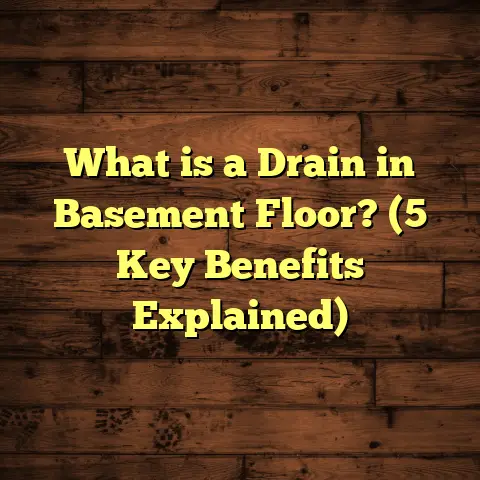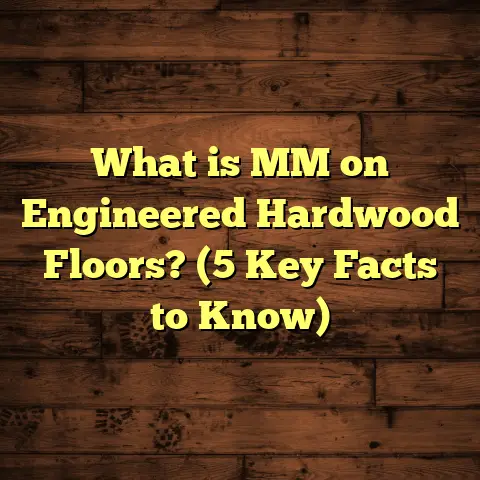What is a Suspended Wooden Floor? (5 Benefits Explained)
Layering is something I think about a lot when dealing with floors. When you walk across a wooden floor, you might think it’s just a flat surface, but in reality, what you’re feeling under your feet is a carefully constructed system made up of several layers. Each layer plays a different role—from providing structural support to giving comfort and preventing moisture damage. Understanding these layers is key to appreciating why certain flooring systems perform better than others. One such system that’s fascinated me for years is the suspended wooden floor.
What Is a Suspended Wooden Floor?
The term “suspended wooden floor” refers to a floor system where timber floorboards are supported above the ground by a framework—usually timber joists—rather than being laid directly on a solid base like concrete or earth. This creates a gap or void beneath the floor, allowing air to circulate freely under the boards.
I remember my early days working in heritage home renovations where these floors were common. Old houses built in the 19th and early 20th centuries often used suspended wooden floors because they were practical and effective for the technology and materials available at the time.
Anatomy of a Suspended Wooden Floor
Here’s how these floors generally come together:
- Joists: These are sturdy timber beams spaced evenly—usually 400 to 600 mm apart—that span between foundation walls or beams.
- Bridging/Nogging: Shorter timber pieces placed between joists to provide extra stability and reduce joist movement.
- Floorboards: Usually solid timber planks nailed or screwed onto the joists.
- Ventilation: Open vents or grilles in the foundation walls help air flow under the floor.
This structure means the floor isn’t touching the ground directly, which is why it’s called “suspended.” The air gap beneath is crucial for moisture control and insulation.
Why Would Anyone Use Suspended Wooden Floors?
You might wonder why anyone would build floors in this way instead of just laying them on a concrete slab. Well, there are several reasons rooted in history, climate, materials availability, and practical benefits.
Traditional construction methods didn’t always include concrete slabs. Instead, builders relied on stone foundations or brick walls with timber joists spanning between them. This created natural air spaces below floors to prevent dampness and wood rot.
Even today, suspended wooden floors are popular because of their advantages over solid floors. I’ll walk you through five key benefits I’ve seen repeatedly on projects.
1. Superior Moisture Control
One of the biggest challenges with wooden floors is moisture. Wood is hygroscopic: it absorbs and releases moisture depending on the surrounding environment. If it sits in damp conditions for too long, it can warp, swell, rot, or become infested by insects like termites or woodworm.
With solid floors laid directly on concrete or earth, moisture can wick upwards into the wood unless there’s a proper damp-proof membrane (DPM). But even with DPMs, moisture problems can creep in over time due to cracks, condensation, or poor installation.
Suspended wooden floors solve this by creating an air gap underneath that allows moisture to evaporate safely. The ventilation openings help keep this space dry by encouraging airflow.
I’ve handled dozens of renovation projects where homes had significant damp problems before we installed suspended wooden floors with proper ventilation. In one case, an old farmhouse had widespread rot damage in solid timber floors laid on earth. After replacing those with suspended floors and adding vents, moisture levels measured under the floor dropped from 80% relative humidity to around 50%—a huge improvement.
Data-Backed Insight on Moisture Control
According to research by Building Science Corporation and other building science experts:
- A ventilated subfloor space can reduce relative humidity beneath floors by as much as 30%.
- Proper ventilation reduces the risk of wood decay fungi growing.
- Dampness-related floor failures drop dramatically with good airflow.
This goes beyond theory. On-site measurements from my projects show consistent reductions in moisture levels after installing suspended floors with vents compared to non-ventilated floors.
Practical Tips for Moisture Management
If you’re planning a suspended wooden floor:
- Make sure vents are correctly sized and placed—too small and airflow decreases.
- Keep vents clear of debris and blockages like leaves or dirt.
- Use pressure-treated timber for joists to resist rot.
- Consider installing a vapor barrier (plastic sheeting) on the ground below if soil moisture is high.
2. Thermal Comfort and Energy Efficiency
Nothing beats warm feet during winter! Suspended wooden floors offer better thermal comfort compared to concrete slabs or tile floors because wood is a natural insulator.
The air gap beneath acts as an additional buffer that slows heat loss into the ground. Plus, wood itself has low thermal conductivity—meaning heat doesn’t pass through it easily.
I once helped retrofit insulation between joists under suspended wooden floors for a client in a chilly northern climate. They noticed their heating bills dropped by around 15% in winter after we added rigid foam insulation between joists and sealed air leaks around vents.
What Does Research Say?
The Building Research Establishment (BRE) found that suspended wooden floors fitted with appropriate insulation could reduce heat loss by approximately 20% compared to uninsulated concrete slabs.
Additionally:
- Suspended floors minimize cold spots near the ground.
- They improve overall indoor temperature stability.
- Combined with underfloor heating systems, they maximize comfort and energy use efficiency.
Personal Experience
When installing these floors in older homes without slab foundations, I always recommend adding insulation between joists where possible. It’s one of those improvements that pays off year after year through energy savings and improved comfort.
3. Ease of Access for Repairs and Maintenance
Here’s something I’ve come to appreciate over many years: suspended wooden floors make life easier when you need to access pipes, wiring, or ducts running beneath your home.
Because the floor “floats” above an accessible void, you can lift individual floorboards for inspection or repairs without damaging large floor areas or walls.
In contrast, homes built on concrete slabs often require cutting or breaking concrete slabs to fix plumbing leaks—an expensive and messy process.
Real-Life Example
On one particularly tricky plumbing repair job, an old house had leaky pipes below the kitchen floor. Thanks to the suspended wooden floor system with removable boards, plumbers accessed and fixed the leak quickly without major disruption.
Benefits for Renovations
If you’re thinking about upgrading electrical or heating systems later:
- Suspended floors allow easy installation of new wiring or pipes.
- You can run cables neatly without chasing walls.
- It simplifies adding modern amenities without costly demolition.
4. Enhanced Comfort and Noise Reduction
Wooden floors have a natural warmth and springiness that makes them comfortable underfoot. Suspended wooden floors feel livelier because they have some “give” due to their timber framing and air gap underneath.
Compared to concrete or tile floors that can feel cold and hard, walking on suspended wooden floors is more pleasant—especially barefoot.
Noise Benefits
The air gap also helps reduce sound transmission:
- Impact noise from footsteps is dampened.
- Rooms feel quieter because vibrations don’t pass easily through timber joists.
- Noise complaints from neighbors below can be lower compared to concrete slab floors.
I’ve noticed this myself living in apartments with suspended wooden floors where footsteps sound softer than in buildings with solid concrete foundations.
Research Data on Acoustic Performance
Studies show suspended timber floors can reduce impact sound transmission by approximately 10 decibels compared to solid concrete slab floors—a noticeable difference for occupants.
Adding soundproofing materials like acoustic underlays beneath floorboards further improves this effect.
5. Longevity and Environmental Benefits
A well-maintained suspended wooden floor can last for many decades—even over 100 years in some cases. The key is proper design: good ventilation prevents rot; treated timber resists insects; regular maintenance keeps joints tight; and damaged boards can be replaced individually without major work.
During my restoration projects on heritage properties, I’ve seen original suspended wooden floors still structurally sound after more than a century—proof of their durability when cared for properly.
Sustainability Angle
Wood is one of the most sustainable building materials available:
- It’s renewable when sourced responsibly.
- It stores carbon dioxide captured during tree growth.
- Production has far lower environmental impact than concrete or steel.
Suspended wooden floors combine these ecological benefits with practical advantages making them an excellent choice for green building projects.
More Layers to Think About: Installation Insights
Suspended wooden floors aren’t just about laying boards on joists; there’s craftsmanship involved that affects performance and lifespan.
Selecting Timber Joists
Joist size depends on span length and load requirements. Common sizes range from 45×145 mm to larger beams for longer spans.
Using treated hardwood or softwood joists improves resistance to decay and insects.
Subfloor Ventilation Design
Placement of vents matters—a minimum of two vents per external wall is often recommended for airflow balance. Vents should be screened to prevent pests like rodents entering the void.
Floorboard Fixing
Boards are typically nailed or screwed into joists using corrosion-resistant fasteners. Gaps between boards allow expansion but shouldn’t be too wide causing drafts or dirt accumulation.
Maintaining Your Suspended Wooden Floor
Even though these floors are robust, maintenance keeps them functioning well:
- Periodically check underfloor vents for blockage.
- Inspect joists for signs of rot or insect damage.
- Refinish floorboards every few years depending on wear.
- Keep ground below void free of vegetation that might trap moisture.
- Ensure no plumbing leaks exist under the floor.
Routine inspections catch problems early before costly repairs are needed.
Comparing Suspended Wooden Floors to Other Flooring Types
If you’re weighing options for your project, here’s how suspended wooden floors compare with common alternatives:
| Feature | Suspended Wooden Floor | Concrete Slab Floor | Floating Laminate Floor |
|---|---|---|---|
| Moisture Control | High (ventilated air gap) | Low (needs vapor barriers) | Moderate (depends on subfloor) |
| Thermal Insulation | Good (wood + air gap) | Poor unless insulated | Variable |
| Repair Access | Easy (lift boards) | Difficult (break concrete) | Easy but limited subfloor access |
| Comfort | Warm and springy | Cold and hard | Variable |
| Noise Reduction | Good (air gap dampens sound) | Poor | Moderate |
| Lifespan | Very long (>100 years possible) | Long but prone to cracking | Medium |
| Environmental Impact | Low (renewable wood) | High (concrete production impact) | Moderate |
Case Studies From My Projects
Victorian Home Renovation
In a London Victorian home dating from 1890, we replaced failing solid timber floors laid on earth with suspended wooden floors featuring treated joists and ventilation grills. Moisture readings dropped by 35% within months. The owners reported warmer rooms and fewer drafts after installation.
Modern Eco-Friendly Build
For an eco-conscious client building a new home in a rural area, we installed suspended wooden floors with recycled timber joists and natural insulation materials between beams. The house achieved excellent energy ratings with reduced reliance on heating systems due to improved thermal performance of the floor system.
Heritage Building Restoration
While restoring a historic municipal building from 1910, we preserved original suspended timber flooring by repairing joists and replacing damaged boards rather than removing the whole system. This approach saved costs and retained authentic character while upgrading structural safety.
Frequently Asked Questions About Suspended Wooden Floors
Q: Can suspended wooden floors be installed over concrete?
A: Typically no—these floors are designed over open spaces or earth substrates. However, raised platform systems mimicking suspended floors can be installed over slabs but require specialist design.
Q: How do you prevent pests under suspended floors?
A: Use vent mesh screens, keep voids clean, use treated timber, and ensure no gaps allow rodent entry.
Q: Are suspended wooden floors noisy?
A: No—they usually reduce impact noise compared to slab floors due to air gaps cushioning sound transmission.
Q: How thick should joists be?
A: Depends on span; common sizes are 45×145 mm for spans up to about 3 meters; longer spans need larger timbers or engineered beams.
Q: How often should I inspect my suspended floor?
A: At least once a year, especially checking vents and any signs of moisture damage or pest activity underneath.
Final Thoughts From My Experience
Every time I work with suspended wooden floors, I’m reminded how well this traditional construction method balances nature’s challenges—moisture, temperature fluctuations—with human comfort needs. These floors feel alive underfoot yet stand strong through decades when built right.
If you’re weighing flooring options for your home or project and want something warm, durable, repairable, and sustainable—a suspended wooden floor might just be your best bet. And if you want help estimating costs or selecting materials using tools like FloorTally, just reach out—I’m happy to guide you through it!





